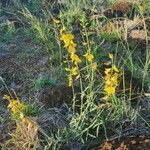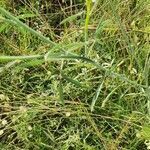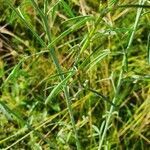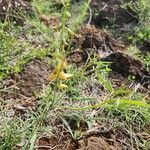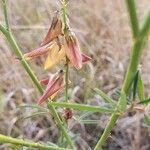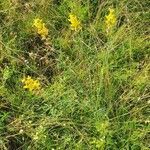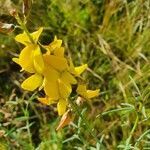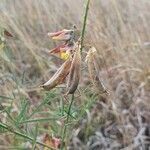Generally erect annual or short-lived perennial, 0.5-2 m tall, with generally numerous ascending branches covered with short appressed or somewhat spreading hairs. Leaves 3-foliolate; leaflets linear or lanceolate to narrowly elliptic-oblong or elliptic, mostly 4-10(-14) x 0.3-2(-3.3) cm, appressed puberulous beneath; petioles shorter than the leaflets. Stipules lacking. Racemes up to 10-50 cm long, somewhat laxly many-flowered; bracts linear-caudate or subulate, expanded at the base, ±1-3.5 mm long; bracteoles inserted at base of the calyx or rarely on the pedicel, subulate or filiform, 0.5-2 mm long. Calyx becoming basally truncate and deflexed against the pedicel, 3-8 mm long, glabrous or appressed puberulous; lobes subulate or acuminate, much shorter than to shortly exceeding the tube. Standard ovate or elliptic, cream or more generally clear yellow, veined reddish brown; wings a little shorter to a little longer than the keel; keel shortly rounded, with a rather long projecting straight, or sometimes slightly recurved, beak, 1.2-2.4 cm long. Legume subsessile, narrowly cylindrical, often a little curved at the ends, (3.5-)4-5 x 0.5-0.7 cm, puberulous or pubescent, with up to 80 or more seeds. Seeds oblique-cordiform, variable in size, up to 2.5-3 mm long, smooth, pale yellow or orange.
A much branched herb. It lives for one or sometimes more years. It grows 2 m tall. The branches curve upwards and have soft hairs. The leaves are alternate. They have 3 leaflets. The leaf stalks are 2-6 cm long. The leaflets are narrow and 4-10 cm long by 1-2 cm wide. They are hairy underneath. The flowers are in a group at the top of the plant. These can be 50 cm long. There are many narrow flowers. They are yellow with red veins. The fruit is a narrow pod 4-5 cm long and 1 cm wide. It is slightly curved at the ends. There are many seeds that are 3 mm long and yellow to orange.
